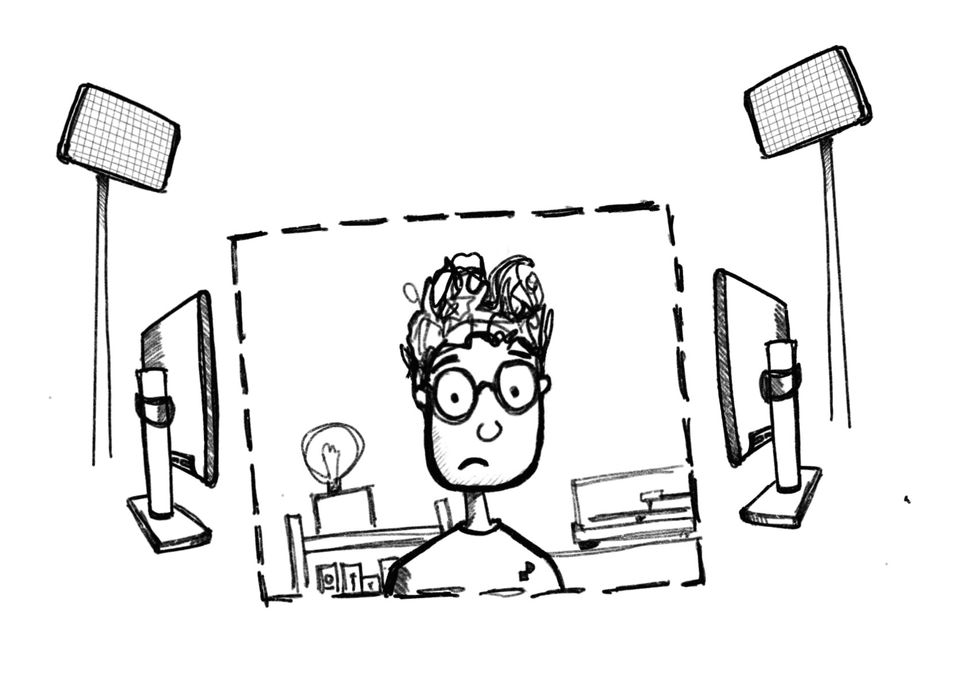Letting go of the script

Note: This post is more of a stream of thought/reflection on my journey into public speaking. No tips or tricks, just thoughts.
Product demos, sharing findings, brown bags, talks... as a creative technologist I get quite a few opportunities to speak in front of an audience. And I gotta say, I find it very exciting. I consider myself a music maker, and one of the things I like the most about music is performing live. Public speaking is and live performance are very similar. You have an idea or concept that you want to share with your audience. You have a plan and some structure on how you want to do it. If you have time rehearse, and then go out on stage, where whatever happens, happens.
With the COVID19 pandemic spiking across the world, in 2020 most people in the tech industry shifted to working fully remote. And so did all presentations. This very quickly became the norm. Fast forward a few months and my office had become a small streaming studio. I carefully picked the lighting, found a few tricks with OBS and other plugins, got a nice mic and headset, but more conveniently, I had an array of screens and artefacts that lived out-of-frame to support my presentation. I could pull up people's faces on one screen, slides and presenter notes on the other, and had my control centre at arms length. I had control over every aspect of my delivery, and more importantly: the script. Like news presenters on tv, I also had a makeshift teleprompter. I could write my presentation to the last detail. Marks, pauses, emphasis, breaks, change slide, etc. I was slightly aware that people could tell I was reading, but the more I practiced the smoother it got. It was a safe way to present. Too safe.
Over time, safe turned into repetitive. Turn on the lights, pull up the slides, notes front and centre and the people window as close to the camera as possible, to try and maintain eye contact. Presenting in front of a camera by yourself, with lights to your face, in the same space where you do everything else, can be fun. It can be safe. But it is also very draining.
The remote presentation honeymoon period was soon over, and I could feel the emptyness. Something was missing. I got distracted with the tech, and the workflow and didn't realise that the best part of presenting wasn't there. You can see your audience and they can see you, but they are not there.
The best part of performing live is connecting with your audience. It closes the loop on the energy field. The performer-audience feedback loop is a very unique moment. It's like a state of flow, where body, mind and self are in sync, gliding through time.
In Australia COVID is still around, but restrictions are almost gone. New opportunities to present in person have started to come up. My first time back on stage was terryfing. I had no control over the space, no clicker, not even my computer, but worst of all... no teleprompter. I used to be comfortable with not having a script, but the remote years were also the time when I did most presentatitions. I lost my muscle. I tried memorising my talks slide by slide, and finding sneaky ways to put the script in front of me. I was back live on stage, but all my energy was focused on "getting it right", and I wasn't enjoying those moments at all. It was time for a change.
I made it a point to drop the script and embrayse the unknown. A good presentation is well structured, thoughtful and intentional, so I wasn't planning on going fully unprepared, but I was ready to leave the safety net behind. It was a gradual process. First I had chunks of script and key phrases. Then bullet points. And finally, I ended up with just a title, and slides to guide me on stage. This transition is still a work in progress, but I've already felt a huge difference. I might not get every line right. I might forget some of the things I thought to share. But in exchange, I get a sense of freedom to take the stories in whatever direction they need to go to better connect with the audience. I try to pick one key message to deliver, and focus the content to support that message. With no script, I get to look up at people, without thinking "I might get it wrong". There is no right or wrong. The audience has no idea about what you had prepared, so you are setting your own expectations. People tend to remember how you made them feel, not exactly what you said.
I am extremely lucky that the company I work for, Telstra Purple, invests heavily in our people. For the last 6 months I've had the opportunity to get some of the best presentation training I could ask for. Amongst many learnings that resonated with me, one principle stood out: a presentation is 50% content and 50% delivery. With this in mind, and letting go of the script, I find I can focus my energy and practice on mastering the performance aspect of public speaking. That skill that helps you connect with your audience and ignite the presenter-audience feedback loop, to get into that state of flow, and enjoy every second on stage.
Remote presentations will still be a thing for a long time and they can be amazing. There's a time and place for them, but if given the choice, I'd pick in-person, every time.